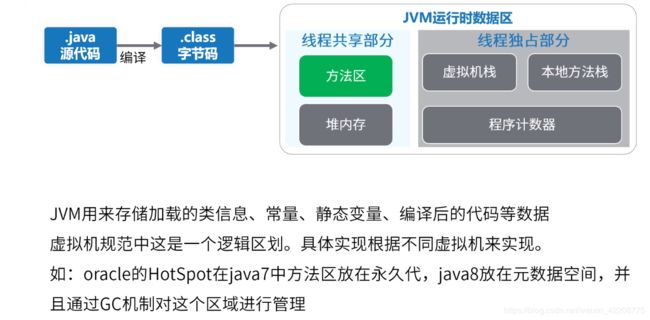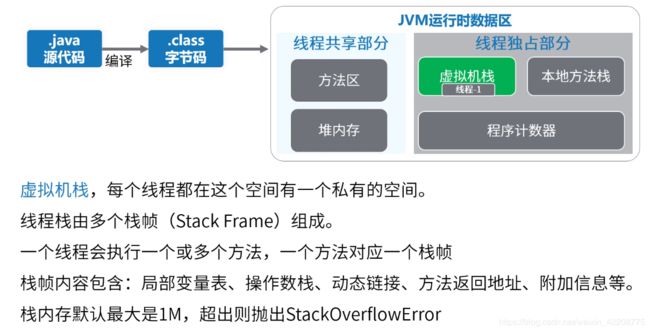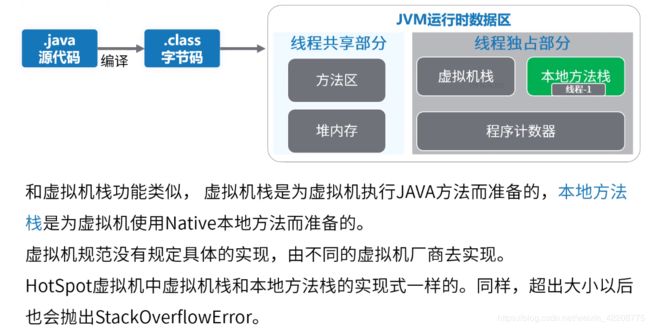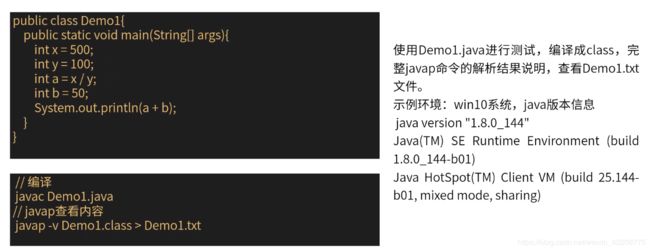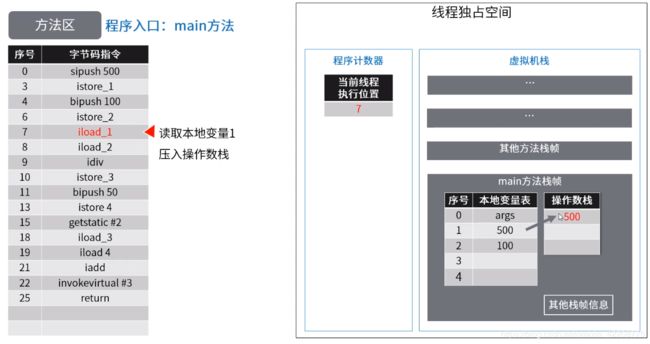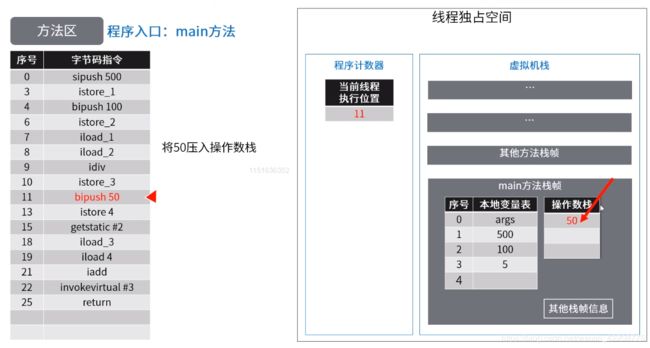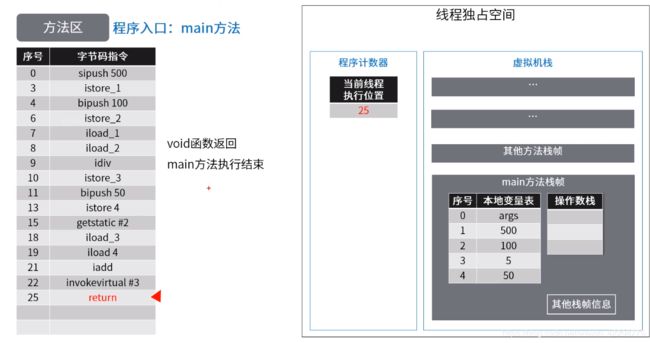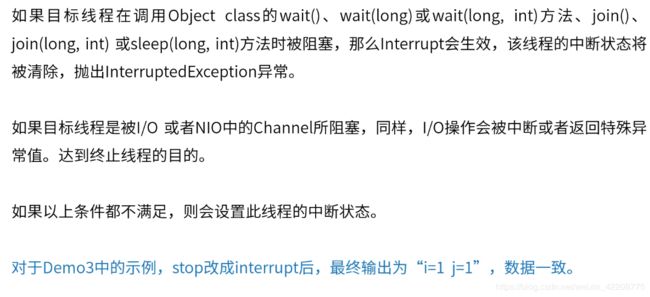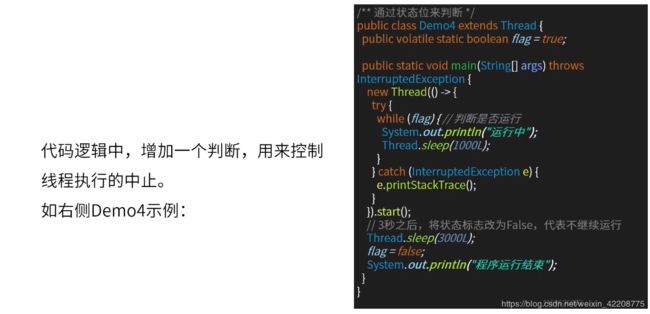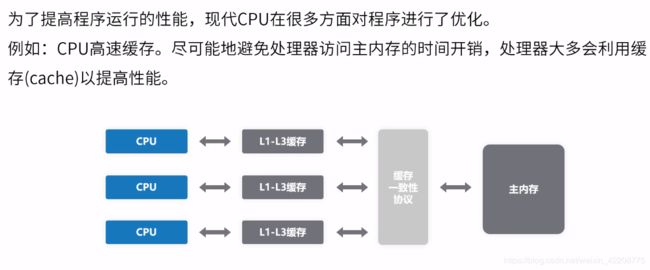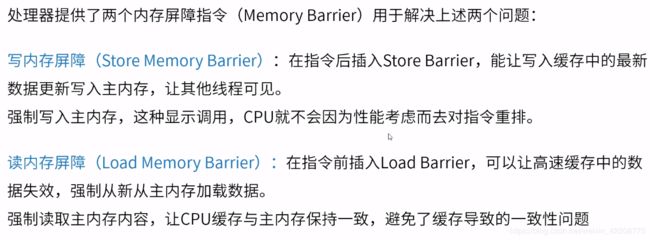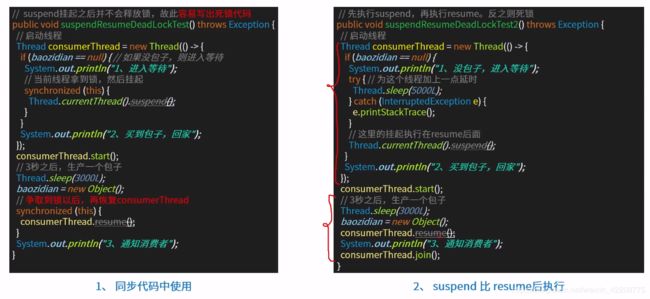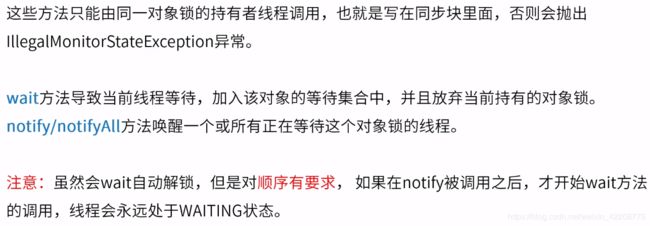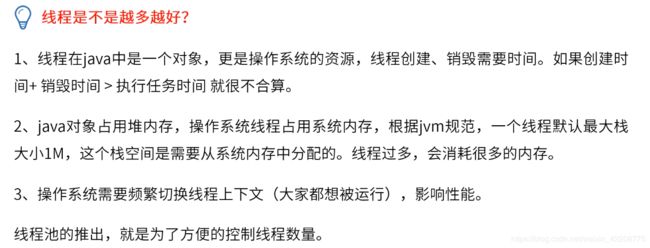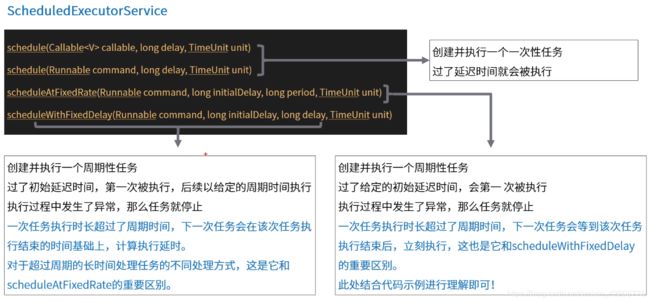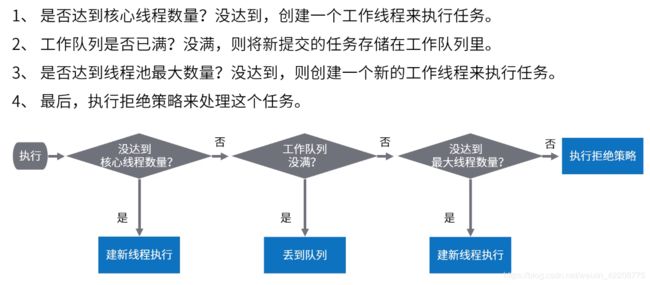网易云课堂微专业--Java高级开发工程师--多线程并发编程--学习笔记(一)
文章目录
- 第一章 多线程并发编程
- 第一节 Java基础
- 1.1.1 Java程序运行原理分析
- class文件内容
- JVM运行时数据区
- 方法区
- 堆内存
- 虚拟机栈
- 本地方法栈
- 程序计数器
- 查看class文件内容
- 程序完整运行分析
- 1.1.2 线程状态
- 多线程运行状态切换源码示例
- 1.1.3 线程终止
- 不正确的线程终止-Stop
- 源码示例
- 正确的线程终止--interrupt
- 源码示例
- 正确的线程终止--标志位
- 1.1.4 内存屏障和CPU缓存
- CPU性能优化手段--缓存
- 多级缓存
- 缓存同步协议
- CPU性能优化手段--运行时指令重排
- CPU性能优化存在的问题
- 解决办法--内存屏障
- 1.1.5 线程通信
- 通信的方式
- 1. 文件共享
- 2. 网络共享
- 3. 共享变量
- 4.jdk提供的线程协调API
- 伪唤醒
- 1.1.6 线程封闭之ThreadLocal和栈封闭
- 线程封闭概念
- ThreadLocal
- 栈封闭
- 1.1.7 线程池应用及实现原理剖析
- 为什么要用线程池?
- 线程池原理--概念
- 线程池API--接口定义和实现类
- 线程池API--方法定义
- ExcutorService
- ScheduleExecutorService
- 实例代码Demo9
- 线程池API--Excutors工具类
- 线程池原理--任务execute过程
- 如何确定合适数量的线程?
第一章 多线程并发编程
第一节 Java基础
1.1.1 Java程序运行原理分析
class文件内容
JVM运行时数据区
方法区
堆内存
虚拟机栈
本地方法栈
程序计数器
查看class文件内容
- class内容-版本号/访问控制

- class内容–常量池

- class内容–构造方法
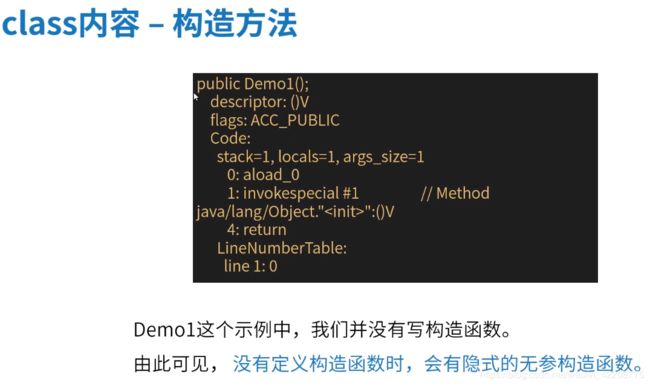
- class内容–程序入口main方法

JVM指令码表下载链接: https://pan.baidu.com/s/1T0h8GgP25vvFRmGx98KtfA 提取码: 92ag
程序完整运行分析
1.1.2 线程状态
多线程运行状态切换源码示例
package com.study.hc.thread.chapter1.thread;
/**
* 示例2 - 多线程运行状态切换示例
*/
public class Demo2 {
public static Thread thread1;
public static Demo2 obj;
public static void main(String[] args) throws Exception {
// 第一种状态切换 - 新建 -> 运行 -> 终止
System.out.println("#######第一种状态切换 - 新建 -> 运行 -> 终止################################");
Thread thread1 = new Thread(new Runnable() {
@Override
public void run() {
System.out.println("thread1当前状态:" + Thread.currentThread().getState().toString());
System.out.println("thread1 执行了");
}
});
System.out.println("没调用start方法,thread1当前状态:" + thread1.getState().toString());
thread1.start();
Thread.sleep(2000L); // 等待thread1执行结束,再看状态
System.out.println("等待两秒,再看thread1当前状态:" + thread1.getState().toString());
// thread1.start(); TODO 注意,线程终止之后,再进行调用,会抛出IllegalThreadStateException异常
System.out.println();
System.out.println("############第二种:新建 -> 运行 -> 等待 -> 运行 -> 终止(sleep方式)###########################");
Thread thread2 = new Thread(new Runnable() {
@Override
public void run() {
try {// 将线程2移动到等待状态,1500后自动唤醒
Thread.sleep(1500);
} catch (InterruptedException e) {
e.printStackTrace();
}
System.out.println("thread2当前状态:" + Thread.currentThread().getState().toString());
System.out.println("thread2 执行了");
}
});
System.out.println("没调用start方法,thread2当前状态:" + thread2.getState().toString());
thread2.start();
System.out.println("调用start方法,thread2当前状态:" + thread2.getState().toString());
Thread.sleep(200L); // 等待200毫秒,再看状态
System.out.println("等待200毫秒,再看thread2当前状态:" + thread2.getState().toString());
Thread.sleep(3000L); // 再等待3秒,让thread2执行完毕,再看状态
System.out.println("等待3秒,再看thread2当前状态:" + thread2.getState().toString());
System.out.println();
System.out.println("############第三种:新建 -> 运行 -> 阻塞 -> 运行 -> 终止###########################");
Thread thread3 = new Thread(new Runnable() {
@Override
public void run() {
synchronized (Demo2.class) {
System.out.println("thread3当前状态:" + Thread.currentThread().getState().toString());
System.out.println("thread3 执行了");
}
}
});
synchronized (Demo2.class) {
System.out.println("没调用start方法,thread3当前状态:" + thread3.getState().toString());
thread3.start();
System.out.println("调用start方法,thread3当前状态:" + thread3.getState().toString());
Thread.sleep(200L); // 等待200毫秒,再看状态
System.out.println("等待200毫秒,再看thread3当前状态:" + thread3.getState().toString());
}
Thread.sleep(3000L); // 再等待3秒,让thread3执行完毕,再看状态
System.out.println("等待3秒,让thread3抢到锁,再看thread3当前状态:" + thread3.getState().toString());
}
}
1.1.3 线程终止
不正确的线程终止-Stop
源码示例
package com.study.hc.thread.chapter1.thread;
/**
* 示例3 - 线程stop强制性中止,破坏线程安全的示例
*/
public class Demo3 {
public static void main(String[] args) throws InterruptedException {
StopThread thread = new StopThread();
thread.start();
// 休眠1秒,确保i变量自增成功
Thread.sleep(1000);
// 暂停线程
// thread.stop(); // 错误的终止
thread.interrupt(); // 正确终止
while (thread.isAlive()) {
// 确保线程已经终止
} // 输出结果
thread.print();
}
}
package com.study.hc.thread.chapter1.thread;
public class StopThread extends Thread {
private int i = 0, j = 0;
@Override
public void run() {
synchronized (this) {
// 增加同步锁,确保线程安全
++i;
try {
// 休眠10秒,模拟耗时操作
Thread.sleep(10000);
} catch (InterruptedException e) {
e.printStackTrace();
}
++j;
}
}
/** * 打印i和j */
public void print() {
System.out.println("i=" + i + " j=" + j);
}
}
正确的线程终止–interrupt
源码示例
正确的线程终止–标志位
package com.study.hc.thread.chapter1.thread;
/** 通过状态位来判断 */
public class Demo4 extends Thread {
public volatile static boolean flag = true;
public static void main(String[] args) throws InterruptedException {
new Thread(() -> {
try {
while (flag) { // 判断是否运行
System.out.println("运行中");
Thread.sleep(1000L);
}
} catch (InterruptedException e) {
e.printStackTrace();
}
}).start();
// 3秒之后,将状态标志改为False,代表不继续运行
Thread.sleep(3000L);
flag = false;
System.out.println("程序运行结束");
}
}
1.1.4 内存屏障和CPU缓存
CPU性能优化手段–缓存
多级缓存
缓存同步协议
CPU性能优化手段–运行时指令重排
CPU性能优化存在的问题
解决办法–内存屏障
1.1.5 线程通信
通信的方式
1. 文件共享
2. 网络共享
暂略。
3. 共享变量
4.jdk提供的线程协调API
- suspend和resume死锁示例(Demo6)
package com.study.hc.thread.chapter1.thread;
import java.util.concurrent.locks.LockSupport;
/** 三种线程协作通信的方式:suspend/resume、wait/notify、park/unpark */
public class Demo6 {
/** 包子店 */
public static Object baozidian = null;
/** 正常的suspend/resume */
public void suspendResumeTest() throws Exception {
// 启动线程
Thread consumerThread = new Thread(() -> {
if (baozidian == null) { // 如果没包子,则进入等待
System.out.println("1、进入等待");
Thread.currentThread().suspend();
}
System.out.println("2、买到包子,回家");
});
consumerThread.start();
// 3秒之后,生产一个包子
Thread.sleep(3000L);
baozidian = new Object();
consumerThread.resume();
System.out.println("3、通知消费者");
}
/** 死锁的suspend/resume。 suspend并不会像wait一样释放锁,故此容易写出死锁代码 */
public void suspendResumeDeadLockTest() throws Exception {
// 启动线程
Thread consumerThread = new Thread(() -> {
if (baozidian == null) { // 如果没包子,则进入等待
System.out.println("1、进入等待");
// 当前线程拿到锁,然后挂起
synchronized (this) {
Thread.currentThread().suspend();
}
}
System.out.println("2、买到包子,回家");
});
consumerThread.start();
// 3秒之后,生产一个包子
Thread.sleep(3000L);
baozidian = new Object();
// 争取到锁以后,再恢复consumerThread
synchronized (this) {
consumerThread.resume();
}
System.out.println("3、通知消费者");
}
/** 导致程序永久挂起的suspend/resume */
public void suspendResumeDeadLockTest2() throws Exception {
// 启动线程
Thread consumerThread = new Thread(() -> {
if (baozidian == null) {
System.out.println("1、没包子,进入等待");
try { // 为这个线程加上一点延时
Thread.sleep(5000L);
} catch (InterruptedException e) {
e.printStackTrace();
}
// 这里的挂起执行在resume后面
Thread.currentThread().suspend();
}
System.out.println("2、买到包子,回家");
});
consumerThread.start();
// 3秒之后,生产一个包子
Thread.sleep(3000L);
baozidian = new Object();
consumerThread.resume();
System.out.println("3、通知消费者");
consumerThread.join();
}
/** 正常的wait/notify */
public void waitNotifyTest() throws Exception {
// 启动线程
new Thread(() -> {
synchronized (this) {
while (baozidian == null) { // 如果没包子,则进入等待
try {
System.out.println("1、进入等待");
this.wait();
} catch (InterruptedException e) {
e.printStackTrace();
}
}
}
System.out.println("2、买到包子,回家");
}).start();
// 3秒之后,生产一个包子
Thread.sleep(3000L);
baozidian = new Object();
synchronized (this) {
this.notifyAll();
System.out.println("3、通知消费者");
}
}
/** 会导致程序永久等待的wait/notify */
public void waitNotifyDeadLockTest() throws Exception {
// 启动线程
new Thread(() -> {
if (baozidian == null) { // 如果没包子,则进入等待
try {
Thread.sleep(5000L);
} catch (InterruptedException e1) {
e1.printStackTrace();
}
synchronized (this) {
try {
System.out.println("1、进入等待");
this.wait();
} catch (InterruptedException e) {
e.printStackTrace();
}
}
}
System.out.println("2、买到包子,回家");
}).start();
// 3秒之后,生产一个包子
Thread.sleep(3000L);
baozidian = new Object();
synchronized (this) {
this.notifyAll();
System.out.println("3、通知消费者");
}
}
/** 正常的park/unpark */
public void parkUnparkTest() throws Exception {
// 启动线程
Thread consumerThread = new Thread(() -> {
while (baozidian == null) { // 如果没包子,则进入等待
System.out.println("1、进入等待");
LockSupport.park();
}
System.out.println("2、买到包子,回家");
});
consumerThread.start();
// 3秒之后,生产一个包子
Thread.sleep(3000L);
baozidian = new Object();
LockSupport.unpark(consumerThread);
System.out.println("3、通知消费者");
}
/** 死锁的park/unpark */
public void parkUnparkDeadLockTest() throws Exception {
// 启动线程
Thread consumerThread = new Thread(() -> {
if (baozidian == null) { // 如果没包子,则进入等待
System.out.println("1、进入等待");
// 当前线程拿到锁,然后挂起
synchronized (this) {
LockSupport.park();
}
}
System.out.println("2、买到包子,回家");
});
consumerThread.start();
// 3秒之后,生产一个包子
Thread.sleep(3000L);
baozidian = new Object();
// 争取到锁以后,再恢复consumerThread
synchronized (this) {
LockSupport.unpark(consumerThread);
}
System.out.println("3、通知消费者");
}
public static void main(String[] args) throws Exception {
// 对调用顺序有要求,也要开发自己注意锁的释放。这个被弃用的API, 容易死锁,也容易导致永久挂起。
// new Demo6().suspendResumeTest();
// new Demo6().suspendResumeDeadLockTest();
// new Demo6().suspendResumeDeadLockTest2();
// wait/notify要求再同步关键字里面使用,免去了死锁的困扰,但是一定要先调用wait,再调用notify,否则永久等待了
// new Demo6().waitNotifyTest();
// new Demo6().waitNotifyDeadLockTest();
// park/unpark没有顺序要求,但是park并不会释放锁,所有再同步代码中使用要注意
// new Demo6().parkUnparkTest();
new Demo6().parkUnparkDeadLockTest();
}
}
伪唤醒
1.1.6 线程封闭之ThreadLocal和栈封闭
线程封闭概念
ThreadLocal
package com.study.hc.thread.chapter1.thread;
/** 线程封闭示例 */
public class Demo7 {
/** threadLocal变量,每个线程都有一个副本,互不干扰 */
public static ThreadLocal value = new ThreadLocal<>();
/**
* threadlocal测试
*
* @throws Exception
*/
public void threadLocalTest() throws Exception {
// threadlocal线程封闭示例
value.set("这是主线程设置的123"); // 主线程设置值
String v = value.get();
System.out.println("线程1执行之前,主线程取到的值:" + v);
new Thread(new Runnable() {
@Override
public void run() {
String v = value.get();
System.out.println("线程1取到的值:" + v);
// 设置 threadLocal
value.set("这是线程1设置的456");
v = value.get();
System.out.println("重新设置之后,线程1取到的值:" + v);
System.out.println("线程1执行结束");
}
}).start();
Thread.sleep(5000L); // 等待所有线程执行结束
v = value.get();
System.out.println("线程1执行之后,主线程取到的值:" + v);
}
public static void main(String[] args) throws Exception {
new Demo7().threadLocalTest();
}
}
栈封闭
1.1.7 线程池应用及实现原理剖析
为什么要用线程池?
线程池原理–概念
线程池API–接口定义和实现类
线程池API–方法定义
ExcutorService
ScheduleExecutorService
实例代码Demo9
package com.study.hc.thread.chapter1.thread;
import java.util.Collections;
import java.util.List;
import java.util.concurrent.LinkedBlockingQueue;
import java.util.concurrent.RejectedExecutionHandler;
import java.util.concurrent.ScheduledThreadPoolExecutor;
import java.util.concurrent.SynchronousQueue;
import java.util.concurrent.ThreadPoolExecutor;
import java.util.concurrent.TimeUnit;
/** 线程池的使用 */
public class Demo9 {
/**
* 测试: 提交15个执行时间需要3秒的任务,看线程池的状况
*
* @param threadPoolExecutor 传入不同的线程池,看不同的结果
* @throws Exception
*/
public void testCommon(ThreadPoolExecutor threadPoolExecutor) throws Exception {
// 测试: 提交15个执行时间需要3秒的任务,看超过大小的2个,对应的处理情况
for (int i = 0; i < 15; i++) {
int n = i;
threadPoolExecutor.submit(new Runnable() {
@Override
public void run() {
try {
System.out.println("开始执行:" + n);
Thread.sleep(3000L);
System.err.println("执行结束:" + n);
} catch (InterruptedException e) {
e.printStackTrace();
}
}
});
System.out.println("任务提交成功 :" + i);
}
// 查看线程数量,查看队列等待数量
Thread.sleep(500L);
System.out.println("当前线程池线程数量为:" + threadPoolExecutor.getPoolSize());
System.out.println("当前线程池等待的数量为:" + threadPoolExecutor.getQueue().size());
// 等待15秒,查看线程数量和队列数量(理论上,会被超出核心线程数量的线程自动销毁)
Thread.sleep(15000L);
System.out.println("当前线程池线程数量为:" + threadPoolExecutor.getPoolSize());
System.out.println("当前线程池等待的数量为:" + threadPoolExecutor.getQueue().size());
}
/**
* 1、线程池信息: 核心线程数量5,最大数量10,无界队列,超出核心线程数量的线程存活时间:5秒, 指定拒绝策略的
*
* @throws Exception
*/
private void threadPoolExecutorTest1() throws Exception {
ThreadPoolExecutor threadPoolExecutor = new ThreadPoolExecutor(5, 10, 5, TimeUnit.SECONDS,
new LinkedBlockingQueue());
testCommon(threadPoolExecutor);
// 预计结果:线程池线程数量为:5,超出数量的任务,其他的进入队列中等待被执行
}
/**
* 2、 线程池信息: 核心线程数量5,最大数量10,队列大小3,超出核心线程数量的线程存活时间:5秒, 指定拒绝策略的
*
* @throws Exception
*/
private void threadPoolExecutorTest2() throws Exception {
// 创建一个 核心线程数量为5,最大数量为10,等待队列最大是3 的线程池,也就是最大容纳13个任务。
// 默认的策略是抛出RejectedExecutionException异常,java.util.concurrent.ThreadPoolExecutor.AbortPolicy
ThreadPoolExecutor threadPoolExecutor = new ThreadPoolExecutor(5, 10, 5, TimeUnit.SECONDS,
new LinkedBlockingQueue(3), new RejectedExecutionHandler() {
@Override
public void rejectedExecution(Runnable r, ThreadPoolExecutor executor) {
System.err.println("有任务被拒绝执行了");
}
});
testCommon(threadPoolExecutor);
// 预计结果:
// 1、 5个任务直接分配线程开始执行
// 2、 3个任务进入等待队列
// 3、 队列不够用,临时加开5个线程来执行任务(5秒没活干就销毁)
// 4、 队列和线程池都满了,剩下2个任务,没资源了,被拒绝执行。
// 5、 任务执行,5秒后,如果无任务可执行,销毁临时创建的5个线程
}
/**
* 3、 线程池信息: 核心线程数量5,最大数量5,无界队列,超出核心线程数量的线程存活时间:5秒
*
* @throws Exception
*/
private void threadPoolExecutorTest3() throws Exception {
// 和Executors.newFixedThreadPool(int nThreads)一样的
ThreadPoolExecutor threadPoolExecutor = new ThreadPoolExecutor(5, 5, 0L, TimeUnit.MILLISECONDS,
new LinkedBlockingQueue());
testCommon(threadPoolExecutor);
// 预计结:线程池线程数量为:5,超出数量的任务,其他的进入队列中等待被执行
}
/**
* 4、 线程池信息:
* 核心线程数量0,最大数量Integer.MAX_VALUE,SynchronousQueue队列,超出核心线程数量的线程存活时间:60秒
*
* @throws Exception
*/
private void threadPoolExecutorTest4() throws Exception {
// SynchronousQueue,实际上它不是一个真正的队列,因为它不会为队列中元素维护存储空间。与其他队列不同的是,它维护一组线程,这些线程在等待着把元素加入或移出队列。
// 在使用SynchronousQueue作为工作队列的前提下,客户端代码向线程池提交任务时,
// 而线程池中又没有空闲的线程能够从SynchronousQueue队列实例中取一个任务,
// 那么相应的offer方法调用就会失败(即任务没有被存入工作队列)。
// 此时,ThreadPoolExecutor会新建一个新的工作者线程用于对这个入队列失败的任务进行处理(假设此时线程池的大小还未达到其最大线程池大小maximumPoolSize)。
// 和Executors.newCachedThreadPool()一样的
ThreadPoolExecutor threadPoolExecutor = new ThreadPoolExecutor(0, Integer.MAX_VALUE, 60L, TimeUnit.SECONDS,
new SynchronousQueue());
testCommon(threadPoolExecutor);
// 预计结果:
// 1、 线程池线程数量为:15,超出数量的任务,其他的进入队列中等待被执行
// 2、 所有任务执行结束,60秒后,如果无任务可执行,所有线程全部被销毁,池的大小恢复为0
Thread.sleep(60000L);
System.out.println("60秒后,再看线程池中的数量:" + threadPoolExecutor.getPoolSize());
}
/**
* 5、 定时执行线程池信息:3秒后执行,一次性任务,到点就执行
* 核心线程数量5,最大数量Integer.MAX_VALUE,DelayedWorkQueue延时队列,超出核心线程数量的线程存活时间:0秒
*
* @throws Exception
*/
private void threadPoolExecutorTest5() throws Exception {
// 和Executors.newScheduledThreadPool()一样的
ScheduledThreadPoolExecutor threadPoolExecutor = new ScheduledThreadPoolExecutor(5);
threadPoolExecutor.schedule(new Runnable() {
@Override
public void run() {
System.out.println("任务被执行,现在时间:" + System.currentTimeMillis());
}
}, 3000, TimeUnit.MILLISECONDS);
System.out.println(
"定时任务,提交成功,时间是:" + System.currentTimeMillis() + ", 当前线程池中线程数量:" + threadPoolExecutor.getPoolSize());
// 预计结果:任务在3秒后被执行一次
}
/**
* 6、 定时执行线程池信息:线程固定数量5 ,
* 核心线程数量5,最大数量Integer.MAX_VALUE,DelayedWorkQueue延时队列,超出核心线程数量的线程存活时间:0秒
*
* @throws Exception
*/
private void threadPoolExecutorTest6() throws Exception {
ScheduledThreadPoolExecutor threadPoolExecutor = new ScheduledThreadPoolExecutor(5);
// 周期性执行某一个任务,线程池提供了两种调度方式,这里单独演示一下。测试场景一样。
// 测试场景:提交的任务需要3秒才能执行完毕。看两种不同调度方式的区别
// 效果1: 提交后,2秒后开始第一次执行,之后每间隔1秒,固定执行一次(如果发现上次执行还未完毕,则等待完毕,完毕后立刻执行)。
// 也就是说这个代码中是,3秒钟执行一次(计算方式:每次执行三秒,间隔时间1秒,执行结束后马上开始下一次执行,无需等待)
threadPoolExecutor.scheduleAtFixedRate(new Runnable() {
@Override
public void run() {
try {
Thread.sleep(3000L);
} catch (InterruptedException e) {
e.printStackTrace();
}
System.out.println("任务-1 被执行,现在时间:" + System.currentTimeMillis());
}
}, 2000, 1000, TimeUnit.MILLISECONDS);
// 效果2:提交后,2秒后开始第一次执行,之后每间隔1秒,固定执行一次(如果发现上次执行还未完毕,则等待完毕,等上一次执行完毕后再开始计时,等待1秒)。
// 也就是说这个代码钟的效果看到的是:4秒执行一次。 (计算方式:每次执行3秒,间隔时间1秒,执行完以后再等待1秒,所以是 3+1)
threadPoolExecutor.scheduleWithFixedDelay(new Runnable() {
@Override
public void run() {
try {
Thread.sleep(3000L);
} catch (InterruptedException e) {
e.printStackTrace();
}
System.out.println("任务-2 被执行,现在时间:" + System.currentTimeMillis());
}
}, 2000, 1000, TimeUnit.MILLISECONDS);
}
/**
* 7、 终止线程:线程池信息: 核心线程数量5,最大数量10,队列大小3,超出核心线程数量的线程存活时间:5秒, 指定拒绝策略的
*
* @throws Exception
*/
private void threadPoolExecutorTest7() throws Exception {
// 创建一个 核心线程数量为5,最大数量为10,等待队列最大是3 的线程池,也就是最大容纳13个任务。
// 默认的策略是抛出RejectedExecutionException异常,java.util.concurrent.ThreadPoolExecutor.AbortPolicy
ThreadPoolExecutor threadPoolExecutor = new ThreadPoolExecutor(5, 10, 5, TimeUnit.SECONDS,
new LinkedBlockingQueue(3), new RejectedExecutionHandler() {
@Override
public void rejectedExecution(Runnable r, ThreadPoolExecutor executor) {
System.err.println("有任务被拒绝执行了");
}
});
// 测试: 提交15个执行时间需要3秒的任务,看超过大小的2个,对应的处理情况
for (int i = 0; i < 15; i++) {
int n = i;
threadPoolExecutor.submit(new Runnable() {
@Override
public void run() {
try {
System.out.println("开始执行:" + n);
Thread.sleep(3000L);
System.err.println("执行结束:" + n);
} catch (InterruptedException e) {
System.out.println("异常:" + e.getMessage());
}
}
});
System.out.println("任务提交成功 :" + i);
}
// 1秒后终止线程池
Thread.sleep(1000L);
threadPoolExecutor.shutdown();
// 再次提交提示失败
threadPoolExecutor.submit(new Runnable() {
@Override
public void run() {
System.out.println("追加一个任务");
}
});
// 结果分析
// 1、 10个任务被执行,3个任务进入队列等待,2个任务被拒绝执行
// 2、调用shutdown后,不接收新的任务,等待13任务执行结束
// 3、 追加的任务在线程池关闭后,无法再提交,会被拒绝执行
}
/**
* 8、 立刻终止线程:线程池信息: 核心线程数量5,最大数量10,队列大小3,超出核心线程数量的线程存活时间:5秒, 指定拒绝策略的
*
* @throws Exception
*/
private void threadPoolExecutorTest8() throws Exception {
// 创建一个 核心线程数量为5,最大数量为10,等待队列最大是3 的线程池,也就是最大容纳13个任务。
// 默认的策略是抛出RejectedExecutionException异常,java.util.concurrent.ThreadPoolExecutor.AbortPolicy
ThreadPoolExecutor threadPoolExecutor = new ThreadPoolExecutor(5, 10, 5, TimeUnit.SECONDS,
new LinkedBlockingQueue(3), new RejectedExecutionHandler() {
@Override
public void rejectedExecution(Runnable r, ThreadPoolExecutor executor) {
System.err.println("有任务被拒绝执行了");
}
});
// 测试: 提交15个执行时间需要3秒的任务,看超过大小的2个,对应的处理情况
for (int i = 0; i < 15; i++) {
int n = i;
threadPoolExecutor.submit(new Runnable() {
@Override
public void run() {
try {
System.out.println("开始执行:" + n);
Thread.sleep(3000L);
System.err.println("执行结束:" + n);
} catch (InterruptedException e) {
System.out.println("异常:" + e.getMessage());
}
}
});
System.out.println("任务提交成功 :" + i);
}
// 1秒后终止线程池
Thread.sleep(1000L);
List shutdownNow = threadPoolExecutor.shutdownNow();
// 再次提交提示失败
threadPoolExecutor.submit(new Runnable() {
@Override
public void run() {
System.out.println("追加一个任务");
}
});
System.out.println("未结束的任务有:" + shutdownNow.size());
// 结果分析
// 1、 10个任务被执行,3个任务进入队列等待,2个任务被拒绝执行
// 2、调用shutdownnow后,队列中的3个线程不再执行,10个线程被终止
// 3、 追加的任务在线程池关闭后,无法再提交,会被拒绝执行
}
public static void main(String[] args) throws Exception {
// new Demo9().threadPoolExecutorTest1();
// new Demo9().threadPoolExecutorTest2();
// new Demo9().threadPoolExecutorTest3();
// new Demo9().threadPoolExecutorTest4();
// new Demo9().threadPoolExecutorTest5();
// new Demo9().threadPoolExecutorTest6();
// new Demo9().threadPoolExecutorTest7();
new Demo9().threadPoolExecutorTest8();
}
}
线程池API–Excutors工具类
线程池原理–任务execute过程
如何确定合适数量的线程?
- CPU利用如果没有达到80%,可以考虑增加线程。
猛戳这里快速前往学习笔记(二)


